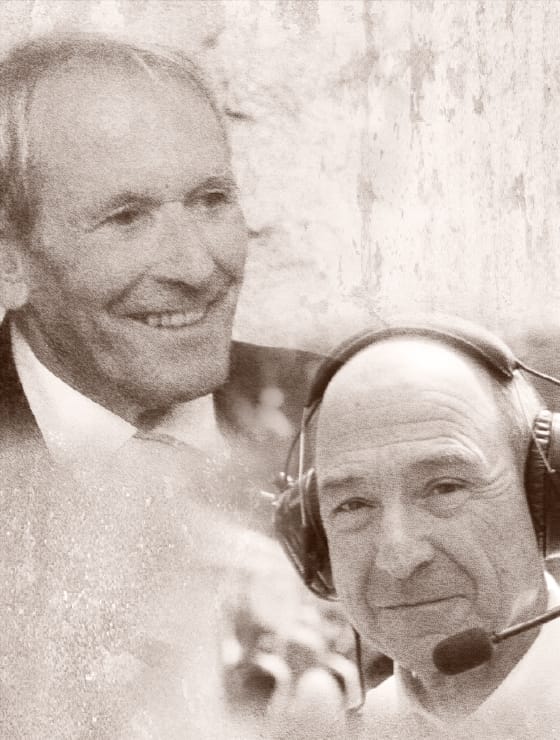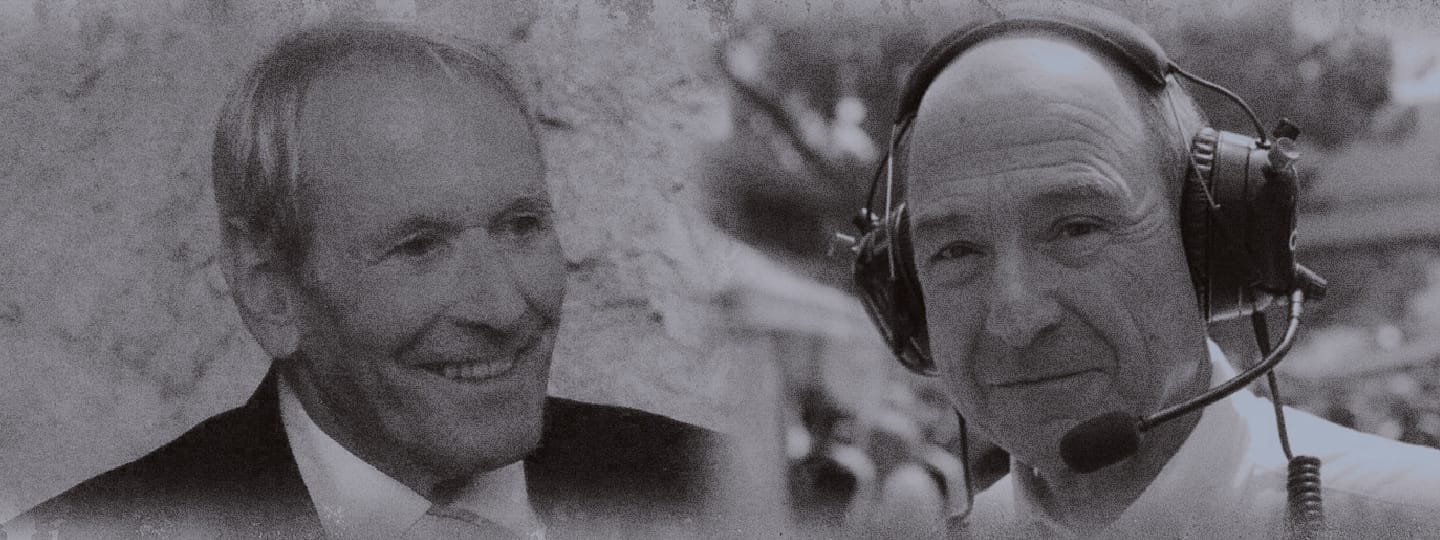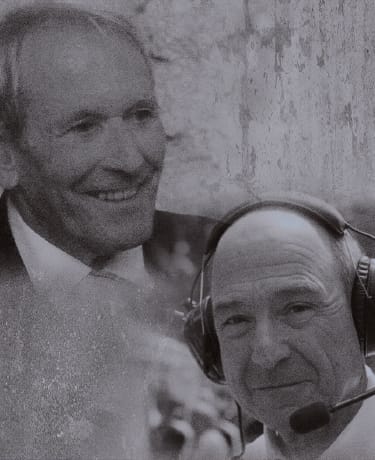
Profile :
While specializing in very different fields, Hans Hess, Swiss sport engineer and an authority in aerodynamic, and Peter Sauber, a founder of Sauber F1 Team, both appear to have a great deal in common.
They spent the greatest part of their working lives in a quest to increase speed in their chosen sports.
Interview in July, 2012
Interview with Hans Hess x Peter Sauber
Q:
Was there a pivotal event that led you in that direction?
A:
Peter Sauber: In my case it was a pure coincidence that I came into contact with motorsport and with the construction of racing cars. But from that moment on, my life was dominated by the challenge of making racing cars faster for more than 40 years.
Hans Hess: It is clear that Peter Sauber and I have much in common, but the scale of my developmental work was somewhat smaller than his F1 technology - being restricted to just the human body and its fabric covering. Overall though, the similarities are in our work in aerodynamics, knowledge of materials and processing, the courage to embrace new ideas, and a large dose of tenacity and staying power.
I suppose the defining moment for me was watching the Lauberhorn downhill race at Wengen in the mid-1960s with Hannes Keller, with whom I had been working on developing new deep-sea diving suits, and being instantly struck by the importance of race suit design to potential victory. By coincidence, representatives of the Swiss Ski Federation and one of their major sponsors were staying in the same hotel as us, and this led to a very happy, financially-backed collaboration, to wind tunnel testing, and ultimately, Olympic gold and silver medals for Swiss men and women in the 1972 Winter Olympics in Sapporo.
Q:
In both motor racing and alpine skiing, cutting fractions of seconds can mean the difference between winning and losing, and the pursuit of aerodynamic perfection is vitally important. What do you regard as your major technical breakthroughs during your career?
A:
PS: Motorsport and skiing have one thing in common: It’s the aim to reduce drag. However, there is another very important aspect in motor racing: down force. In this regard, the introduction of front and rear wings on racing cars marked a significant technical breakthrough.
HH: We produced a completely new three-layered Descente ski racing suit for the 1979 World Cup, consisting of a surface skin of fine yarns, bonded to an inner liner with a new foam adhesive, which, though complicated, made a substantial reduction in wind resistance, while managing to meet the FIS air permeability rules.By the fifth race of the season, in Crans Montana (in Switzerland) all three place-getters were wearing the Descente suit, and after that, everyone else wanted it too, including the struggling Austrian team. Descente instructed me to make suits for the Austrians, but the only material available at our factory in Aadorf in the right timeframe was green, instead of their national red and white colors. The turnaround in Austrian fortunes was dramatic, and Austrian skiers began returning to the winners’ podiums – all in their frog green suits. By the last race of the season the top nine racers were all wearing the new Descente suit.
Q:
You would have seen a great deal of improvement in times over the course of your career. Do you think that there is still room for improvement, or have physical limits now been reached?
A:
PS: If you look at the history of sports, for decades human beings haven’t stopped jumping higher or running faster. The same goes for race cars. They are going faster all the time and limits are still being pushed.
HH: Today, while all of my work remains fresh in my memory, I am quite certain that the physical limits have not yet been reached. Just look at F1, where its development specialists still strive to overcome challenges relating to even the smallest details in their constant quest to push the boundaries further.
From my own experience, I can only say you have to keep working – researching and developing and never giving up! As everything in the universe proves to us time and time again, the process of development must go on.
Q:
Seeing your behind the scenes achievements put into practice – on the slopes or on the track - must have been very satisfying. Is there any one particular victory that stands out in your mind?
A:
PS: It was our first victory in Formula One, placing one-two in 2008 in Montreal, when Robert Kubica finished ahead of teammate Nick Heidfeld. It was a special feeling making it to the top in F1, which is at the pinnacle of motorsports.
HH: It is always very gratifying to see how your technical developments actually perform when put to use, and I have been fortunate is seeing my work achieve success in a very wide range of sports in addition to downhill skiing. Among the most memorable were revolutionary cycling suits, highly acclaimed speed skating suits that made their debut at the 1976 Winter Olympics at Innsbruck, suits for ski jumping, skeleton, luge and bobsled racers, and also for the Swiss multiple world sidecar champions, Rolf Biland and Kurt Waltisberg.
Q:
Which sporting personalities in your field did you most enjoy working with, and why?
A:
PS: In my long career in motorsports I have had the privilege of working with great personalities such as Michael Schumacher, Kimi Räikkönen, Jacques Villeneuve and Kamui Kobayashi.
HH: To be honest, there were very few sporting personalities I really enjoyed working with. I much preferred my associations with the behind-the-scenes specialists, like the aerodynamic technicians in the small wind tunnel at the Swiss Federal Institute of Technology in Zurich and at the large wind tunnel in Emmen. I particularly liked sharing thoughts with Karl Frehsner, the former men’s team coach at the Swiss Ski Federation, who always had good ideas and was extremely cooperative.
Q:
You have both had considerable involvement with Japan during your careers. Descente’s successful ski racing suits and support for F1 driver Kamui Kobayashi spring immediately to mind. Has working with Japan and Japanese been memorable in any particular way?
A:
PS: It was in 1985 when we participated for the first time in a sports car race in Japan. In 1989 and 1990 we won the 1000km race in Suzuka, and we went to Japan 20 times in Formula One. It is clear that you start building a relationship with a country when you go there so many times. And now, we have had Kamui Kobayashi in our team for two and a half years. In my view he is not only the best ever Japanese Formula driver, he is also a warm hearted, very friendly person, and it’s a pleasure to work with him.
HH: I would just like to say, speaking purely on the basis of my own experience, that working with Japan and the Japanese over very many years was very rewarding, and marked by a great deal of mutual respect and trust. Together we shared many wonderful sporting achievements. I am most grateful to Descente for its generous support for my work over all of that time.
Q:
What do you see as the challenges ahead for those who will follow in your footsteps in years to come?
A:
PS: I expect what maybe everybody in my position would expect: that my successors do things even better than I did.
HH: The most important factor in research, development and long-term planning is to utilize every possible resource to achieve what you believe in. To be successful, you have to become totally absorbed in your work, maintain your vision, and possess a large dose of courage to pursue new ideas. And, it goes without saying, you must have a strong personality.
There are times when new developments cannot be managed only with the resources of your own company. When others need to be drawn in to work on a project, it should be allocated piece by piece to ensure in-house confidentiality is preserved.
*Air permeability tesing: Testing required by FIS to determine the air permeability of the fabric used in suits for downhill skiing. Fabric must maintain a minimum permeability of 30 liters per m2/second ). downhill racing suits treated with a surface coating appeared on the ski scene, but after multiple close-calls and a concern over both safety and athlete health, a rule banning slippery surface coatings was established in 1977.

